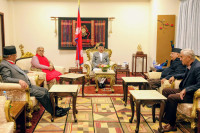Opinion
Focus on trade
BIMSTEC seems to have too many things on its plate which is slowing it down
Bijendra Man Shakya
The fourth summit of the Bay of Bengal Initiative for Multi-Sectoral Technical and Economic Cooperation (BIMSTEC) concluded recently in Kathmandu by widening the areas of cooperation among the member states. BIMSTEC already has a plethora of programmes on its plate ranging from trade, tourism and investment to technology, transportation and transmission lines. The number of items on its agenda went up to 16 with the summit proposing two new appealing programmes—blue economy and mountain economy. This raises a question whether BIMSTEC should widen or deepen the areas of cooperation.
Broadening the areas of cooperation is fine as long as there is progress, but BIMSTEC has lagged behind with respect to the implementation aspect. In fact, it has been moving ahead at a snail’s pace since its inception two decades ago. Realising this reality, a BIMSTEC ministerial meeting held a year ago in Kathmandu emphasised deepening rather than widening the areas of cooperation which was intended to give its members a feeling of regional economic integration. But instead of sticking to this commitment and taking stock of the existing areas of cooperation, the recent Kathmandu summit seems to have gone too far without determining a definite destination.
Trade first
As in all other regional groupings, trade should remain at the heart of BIMSTEC in order to achieve effective economic integration. Trade is the driving force behind other implications in regional groupings. This is why the level of economic integration is judged on the basis of the static gain of trade creation among the member countries.
The European Union (EU) is a splendid example of economic integration with intra-regional trade standing at 69 percent in 2015. Similarly, trade between the North American Free Trade Agreement (NAFTA) and other North American countries has reached 50 percent while 40 percent of the total trade of the Association of Southeast Asian Nations (ASEAN) occurred among its member nations. But the issue of trade liberalisation within BIMSTEC has remained at a standstill notwithstanding the provision regarding a fast-track approach to reducing tariffs among the member countries.
The third BIMSTEC summit in Myanmar in 2014 had insisted on finalising the draft agreement on trade in goods. It was supposed to adopt two approaches for tariff reduction (normal and fast track) and reach understandings on trade dispute settlement, rules of origin, and business visa schemes in a bid to promote intra-regional trade.
But the recent Kathmandu summit kept mum on these issues and the Framework Agreement for a BIMSTEC Free Trade Area which should have drawn immense attention. Interestingly, no explanation on this issue was given. A declaration was made for the sake of formality that the negotiations on free trade would be given continuity. Thus there is little prospect of expanding intra-regional trade in the near future.
It is well perceived that there is a progressive relationship between trade creation as a static gain and other possible dynamic impacts, such as investment, technology, economies of scale and competition through economic integration. It suggests that trade can be a decisive means to achieve other aims of regional integration. Based on this basic economic reality, BIMSTEC needs to pursue a fast-track approach with regard to negotiations on tariff reduction to achieve its goal of trade liberalisation. However, free trade will have differing impacts on the member countries, and it will depend on bilateral request-and-offer and the terms of trade of individual members.
For economically vulnerable countries like Nepal, the immediate impact of free trade can be unfavourable unless there is a radical change in its trade structure and pattern.
It is also equally important to understand that trade cannot be liberalised without harmonising the policies on complex trade-related issues, including rules of origin, standards and trade facilitation measures among the member countries. This is crucial for minimising possible trade disputes in the future and for utilising strategic access to major growing markets within the region for the expansion of intra-regional trade. Once tangible benefits from trade are assured, there is a vast possibility of cooperation in other dynamic economic areas which will ultimately lead to the goal of ending poverty in all BIMSTEC countries by 2030 as stipulated by the fourth summit.
Complementary or contradictory.
Amid these unsettled issues, the Kathmandu Summit was mired in widespread speculation that BIMSTEC was evolving as a substitute for the waning South Asian Association for Regional Cooperation (SAARC). But one should think why economic groupings of particular regions cannot coexist with each other. In a globalised world economy, barring political interests, regional cooperation need not be self-competing and can exist together with overlapping.
There are about 300 overlapping economic groupings notified to the World Trade Organisation (WTO), which assigned world renowned economists to undertake a study to assess whether the growing number of economic blocs was a threat to the international trading system. The study concluded that the expansion of regional blocs was complementary and not contradictory to world trade and economic growth. So if we believe in this popular norm, BIMSTEC can complement SAARC instead of substituting it. Like the EU’s eastward expansion, BIMSTEC can be instrumental in promoting expansion towards the east and the west. While its extension towards the east can link other vibrant ASEAN economies, there is an equal chance of westward expansion too.
Shakya is an associate professor of economics at Tribhuvan University.




 6.12°C Kathmandu
6.12°C Kathmandu











